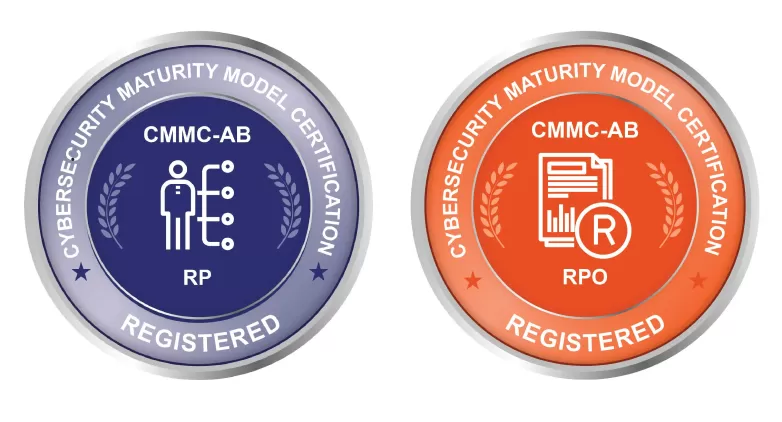CMMC Consulting
- Strategic Guidance to Help Your Organization Achieve and Maintain CMMC Compliance
- What Is the Cybersecurity Maturity Model Certification 2.0 (CMMC)?
- Tiered CMMC Levels and Requirements
- Our CMMC Consulting Services
- Why Trust CBIZ Pivot Point Security Consulting for CMMC?
- CMMC FAQs
- Start Your CMMC Compliance Journey
- CMMC Resources
Strategic Guidance to Help Your Organization Achieve and Maintain CMMC Compliance
All contractors and subcontractors in the U.S. Defense Industrial Base (DIB) will soon be required to comply with Cybersecurity Maturity Model Certification (CMMC). This multi-level security framework protects sensitive government information from cyber breaches and threats to national security within the defense supply chain.
CBIZ Pivot Point Security is here to guide your organization to a successful CMMC certification. We tailor our consulting services to your unique situation, working with you to determine what it will take for your organization to achieve and maintain compliance at your designated CMMC level.
What Is the Cybersecurity Maturity Model Certification 2.0 (CMMC)?
Since 2020, the U.S. Department of Defense (DoD) has been working to improve cybersecurity within the DIB. The CMMC is a DoD program that ensures contractors and subcontractors can safeguard Federal Contract Information (FCI) and Controlled Unclassified Information (CUI).
The CMMC Final Rule, also called CMMC 2.0, was published on October 15, 2024. Its goal is to protect sensitive data shared with defense contractors and subcontractors during projects. CMMC 2.0 streamlines requirements and aligns with existing and widely accepted cybersecurity standards like NIST SP 800-171.
The CMMC Final Rule has three key features:
- Tiered levels: The CMMC program outlines three progressively advanced levels. Organizations must implement progressively advanced cybersecurity standards based on the sensitivity of the information handled.
- Assessment requirements: Companies must demonstrate compliance with their chosen CMMC level through self-attestation or a third-party assessment.
- Contract requirements: Contracts will specify a CMMC level organizations must achieve as a condition of contract award.
Consultation services from CBIZ Pivot Point Security will help you identify the steps necessary to meet the latest CMMC compliance standards.
Struggling with all the new terminology in the CMMC? Learn all the key CMMC terms and acronyms.
Tiered CMMC Levels and Requirements
If you are a DoD supplier, you will need to identify your required CMMC level. Under the final compliance rule, you must be certified to the appropriate CMMC level to win defense contracts.
Based on the information you manage, your organization may need to achieve one of three levels. Each level differs in security controls and assessment requirements. CBIZ Pivot Point Security can help you define the CMMC level your organization must adhere to and ensure all required controls are in place.
Level 1 Compliance: Foundational Requirements
This certification level ensures a company can protect less critical FCI. An annual self-assessment consisting of 17 security controls outlined in Federal Acquisition Regulation (FAR) Clause 52.204-21 is required. Audits can occur anytime, so contact CBIZ Pivot Point Security to ensure your organization's readiness.
Level 2 Compliance: Advanced Security Protocols
Level 2 certification addresses the protection of CUI. This more advanced level covers 110 requirements aligned with NIST SP 800-171, with third-party assessments mandated every three years. Annual self-assessment may be allowed for information not deemed critical to national security.
Level 3 Compliance: Expert Cybersecurity Standards
The Expert level builds on CMMC Level 2. High-priority DoD suppliers must meet 134 requirements, including additional cybersecurity standards based on NIST 800-172. The federal government assesses compliance every three years and requires annual affirmations.
Our CMMC Consulting Services
Protecting controlled government and military data from security breaches is critical to national security. Yet, many organizations struggle to understand control requirements and which systems need protecting. Compliance with CMMC standards is no longer optional if you plan to do business with the DoD. While you may have only been required to self-attest until now, that’s all about to change.
No matter where you are in your CMMC compliance journey, we can help. We are here to get you started with the certification process well before program deadlines so that you remain competitive and appealing to government agencies and your investors.
Our expert consultants will provide you with a complete CMMC compliance strategy. This customized plan will help you achieve certification and may include the following consultation services:
CMMC Scoping and Risk Assessment:
Let us help you determine how CUI flows to, within and from your organization. This will constitute the “scope” of your CMMC System Security Plan (SSP) — or the extent to which your organization needs to be compliant. We’ll then conduct a risk assessment to identify known potential vulnerabilities to CMMC-relevant controls.
CUI Identification and Management
During scoping and risk assessment, we identify both basic and specified forms of Controlled Unclassified Information (CUI). Identifying specific forms that require additional treatments above and beyond CMMC requirements is critical, especially ITAR data. Our consulting services offer in-depth guidance to securely manage both basic and ITAR-related CUI, aligning with CMMC and ITAR compliance. This includes thoroughly analyzing your data flow and storage and adhering to strict security protocols required by the U.S. Department of Defense to mitigate compliance risks and legal penalties.
CMMC Gap Analysis:
We’ll assess your current cybersecurity setup against CMMC standards to identify gaps that need to be filled to keep your system up to par.
Implementation Support:
Once gaps are clearly outlined and risks are identified, we can assist your team in implementing all necessary controls, policies, procedures and any missing requirements. This process could range from setting up new security measures to improving existing systems.
Documentation Assistance:
CMMC standards require organizations to create and maintain extensive documentation. We can help you prepare these documents, including SSPs outlining your organization’s current security measures and Plans of Action and Milestones (POA&Ms) detailing how you plan to address outstanding security issues.
Ongoing Compliance Support:
CMMC compliance is not a one-and-done process. Once you’ve achieved certification at your required level, we provide continuing support to maintain compliance and prepare your organization for future assessments or audits.
Why Trust CBIZ Pivot Point Security Consulting for CMMC?
The CMMC Final Rule took effect in December 2024. Yet, compliance looks different for every organization. Whether you wish to meet the most strenuous standards specified in NIST SP 800-171 and 800-172 or remain ready for a CMMC Level 1 audit, we can help.
For over 20 years, CBIZ Pivot Point Security has supported clients in validating that key networks, applications and systems are secure and compliant. We work with organizations in the most highly regulated sectors, including government contractors and subcontractors who rely on DoD projects as a substantial percentage of their revenue.
Our tailored approach meets your organization where it’s at, assessing its unique needs to create a highly detailed roadmap to CMMC compliance. Once your organization is in a position to prove it’s secure and compliant, you will have peace of mind knowing you’re equipped to identify and triage cyber incidents. Plus, you’ll be free to pursue government contracts that empower your business to thrive.

CMMC FAQs
The Cybersecurity Maturity Model Certification (CMMC) is a three-level framework to protect Controlled Unclassified Information (CUI) across over 300,000 companies in the U.S. Defense Industrial Base (DIB).
Any company engaged in a contract or subcontract with the U.S. Department of Defense (DoD) will need to achieve certification at one of the three CMMC levels — possibly from an accredited CMMC Third-Party Assessor Organization (C3PAO).
CMMC has three certification levels corresponding to different cybersecurity maturity requirements:
- CMMC Level 1 (Basic Cyber Hygiene) is required for any organization that stores, transmits or processes Federal Contract Information (FCI).
- CMMC Level 2 (Good Cyber Hygiene) is required for any organization that stores, transmits or processes Controlled Unclassified Information (CUI).
- CMMC Level 3 (Expert) is required for any organization that handles CUI and faces Advanced Persistent Threats (APTs).
To get CMMC certified, working with a compliance expert like CBIZ Pivot Point Security, who can guide you through the certification process, is crucial. This will include:
- Determining your target CMMC level.
- Developing a CMMC compliance roadmap to assess your cybersecurity maturity and close gaps.
- Choosing a C3PAO.
- Scheduling and undergoing a CMMC assessment.
- Addressing nonconformities within 90 days.
- Receiving a CMMC compliance certificate, good for three years.
- Conducting annual self-assessments.
Your CMMC certification depends on your role in the DIB and the type of information your organization handles. Organizations that process CUI as part of a DoD contract should prepare now, as you will need to demonstrate compliance with CMMC Level 2.
Organizations that deal with non-classified information may only need CMMC Level 1 clearance while remaining vigilant in case of security audits.
The CMMC Final Rule took effect on December 16, 2024. New DoD contract requirements will begin in early 2025.
In other words, now is the time to contact CBIZ Pivot Point Security’s expert consultants to ensure your eligibility and readiness for new contracts.
The CMMC program will utilize a four-phase implementation plan over three years. This phased process is meant to give organizations the time to understand CMMC standards and address ramp-up issues.
- Phase 1 (Early to mid 2025): CMMC Level 1 and Level 2 self-assessments will be prerequisites for all relevant DoD contracts.
- Phase 2 (2026): Beginning in the next calendar year after Phase 1, CMMC Level 2 certification will require a third-party assessment from an accredited C3PAO.
- Phase 3 (2027): One year after Phase 2 implementation, CMMC Level 3 certification requirements will be added for contracts with the most sensitive CUI.
- Phase 4 (2028): The full implementation phase will mandate compliance with your organization’s appropriate CMMC level.
C3PAOs play a critical role in ensuring government contractors and subcontractors meet the DoD’s cybersecurity requirements. A nonprofit accreditation entity called the Cyber Accreditation Body (Cyber AB) onboards C3PAOs, which then train and certify their auditors to conduct CMMC assessments.
If you need a third-party CMMC assessment, CBIZ Pivot Point Security will help you find a certified C3PAO to schedule an audit.
Depending on your current cybersecurity status and the CMMC level you want to achieve, now is the time to prepare for full CMMC compliance. The implementation process can be quite lengthy, and it’s essential that you retain your competitive advantage as a fully certified organization. CBIZ Pivot Point Security will get you there.
Our CMMC consultancy services give you a clear timeline of what it will take to reach provable compliance, giving you a firm advantage over your competitors when responding to DoD requests for information (RFIs) and requests for proposals (RFPs).
Start Your CMMC Compliance Journey
Turn to CBIZ Pivot Point Security and start your CMMC certification process on the right foot. We provide a clear compliance plan, so you know exactly what it takes to achieve your desired CMMC level and win DoD contracts. Protect your business and grow your future. Contact us today to schedule a meeting with one of our compliance experts.






